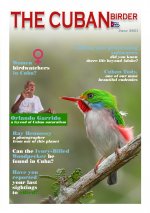Birding Havana
Member

Dear bird lovers!
Issue No.2 of the quarterly magazine The Cuban Birder was launched on June 1!
Free download at: www.thecubanbirder.wordpress.com
Please, spread the voice!
Thanks so much in advance!!
Here goes the article about the endemic: Cuban Tody
****
CUBAN TODY
Cartacuba / Todus multicolor
one of our most beautiful endemics
By Vladimir Mirabal
This bird is a real prize for the observer when it comes within reach of his binoculars or camera. The combination of bright green, blue, red, pink, yellow and white colors on a small, stubby body make the Tody one of our most beautiful endemics.
There are five species of Tody in the world and all are found exclusively in the Caribbean. In Cuba the Tody can be found throughout the country, the Isle of Youth and in the large keys. It inhabits shady forests and coastal vegetation, where it scans the branches for insects, caterpillars, spiders and small lizards. It is usually found alone or in pairs and its presence is often noticed by a characteristic buzzing sound that it makes at will with its wings as a method of scaring off insects and thus catching them more easily. Because of this peculiar sound, it is also known as ‘Pedorrera’ (Farter).
The Tody builds its nests, between April and June, in vertical ravines of limestone rock, earth or mud. It also uses rotten logs to dig a tunnel and at the end of this tunnel it builds a larger chamber where the female deposits 3 white eggs. Both the male and female work on the construction of the nest in alternating shifts of digging and as the tunnel progresses they coat its walls with a mixture of lichens, grasses, algae and feathers that serve as a sealant. As part of the mating ritual, the male Tody feeds his female and will continue to feed her until the eggs have hatched. For this reason, the Tody can be seen foraging in the bushes practically all day long. They are very territorial and will defend their nest without fear.
Often, when it notices the presence of the observer it does not flee, but remains still on a branch moving its large head up and down and may also vocalize its tot-tot-tot which can be heard for several meters around. That would be the best moment to take pictures of it and enjoy it through binoculars, something that should be done quickly because the magic of the moment can last only a few seconds.
Issue No.2 of the quarterly magazine The Cuban Birder was launched on June 1!
Free download at: www.thecubanbirder.wordpress.com
Please, spread the voice!
Thanks so much in advance!!
Here goes the article about the endemic: Cuban Tody
****
CUBAN TODY
Cartacuba / Todus multicolor
one of our most beautiful endemics
By Vladimir Mirabal
This bird is a real prize for the observer when it comes within reach of his binoculars or camera. The combination of bright green, blue, red, pink, yellow and white colors on a small, stubby body make the Tody one of our most beautiful endemics.
There are five species of Tody in the world and all are found exclusively in the Caribbean. In Cuba the Tody can be found throughout the country, the Isle of Youth and in the large keys. It inhabits shady forests and coastal vegetation, where it scans the branches for insects, caterpillars, spiders and small lizards. It is usually found alone or in pairs and its presence is often noticed by a characteristic buzzing sound that it makes at will with its wings as a method of scaring off insects and thus catching them more easily. Because of this peculiar sound, it is also known as ‘Pedorrera’ (Farter).
The Tody builds its nests, between April and June, in vertical ravines of limestone rock, earth or mud. It also uses rotten logs to dig a tunnel and at the end of this tunnel it builds a larger chamber where the female deposits 3 white eggs. Both the male and female work on the construction of the nest in alternating shifts of digging and as the tunnel progresses they coat its walls with a mixture of lichens, grasses, algae and feathers that serve as a sealant. As part of the mating ritual, the male Tody feeds his female and will continue to feed her until the eggs have hatched. For this reason, the Tody can be seen foraging in the bushes practically all day long. They are very territorial and will defend their nest without fear.
Often, when it notices the presence of the observer it does not flee, but remains still on a branch moving its large head up and down and may also vocalize its tot-tot-tot which can be heard for several meters around. That would be the best moment to take pictures of it and enjoy it through binoculars, something that should be done quickly because the magic of the moment can last only a few seconds.




